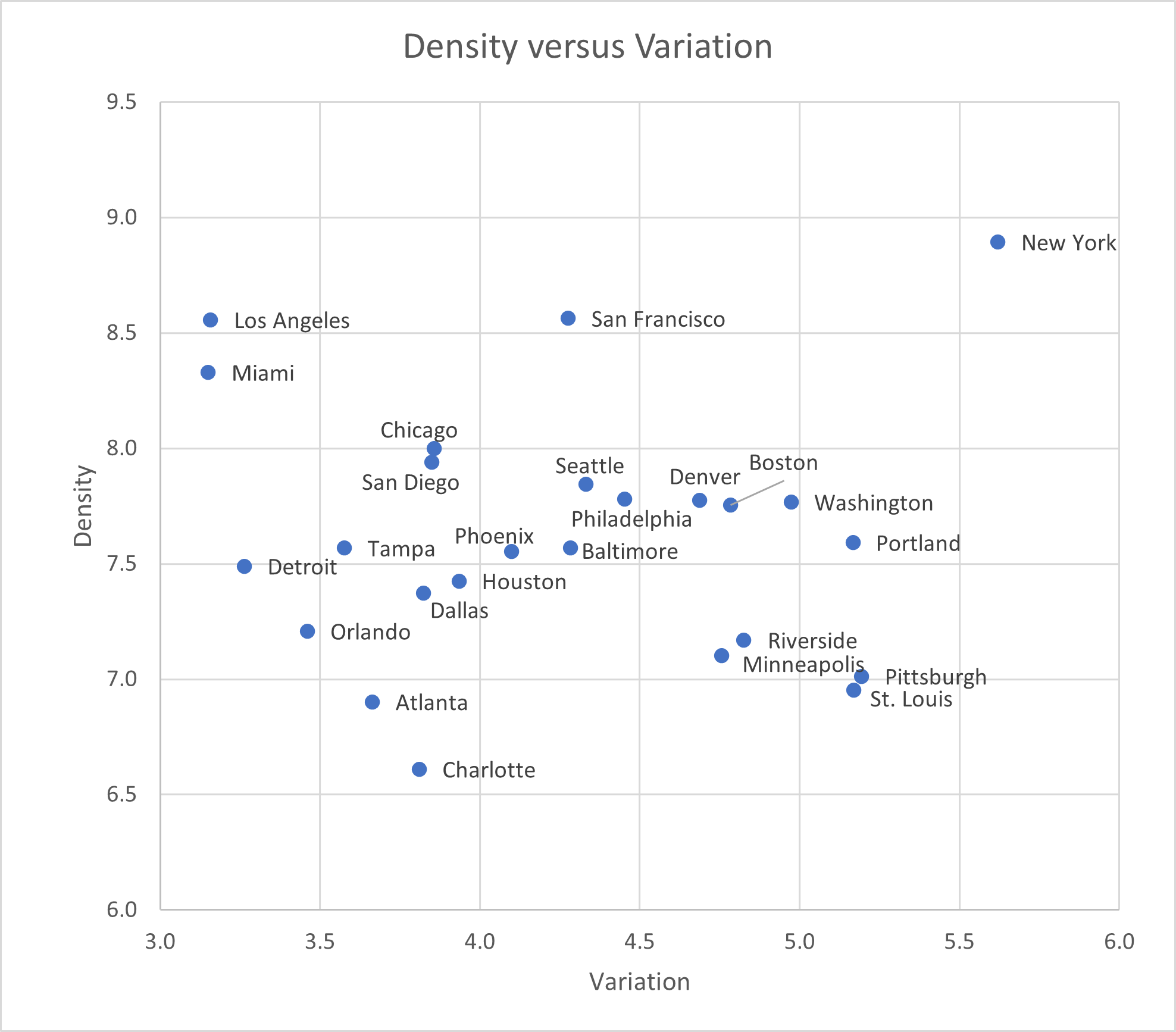Physical Address
304 North Cardinal St.
Dorchester Center, MA 02124
Physical Address
304 North Cardinal St.
Dorchester Center, MA 02124
The narrow choice of city versus suburb is a balance of cost and amenities. But the bigger question – in which region should I make my home? – requires one to look on a higher plane.
A recent Youtube video on New York City’s “Billionares’ Row” (a smattering of very expensive buildings at the northern edge of midtown Manhattan) has received over six million views. Much of the video is rather propagandistic: it uses perjorative terms like “loopholes” to describe how the supertalls on Billionaires’ Row complied with zoning codes. The video relied heavily on sources such as socialist Sam Stein (who generally opposes market-rate housing). Having said that, this video does contain some interesting information. In particular, the video points out that to the extent that the condos in these buildings are vacant, it isn’t necessarily because the owners are treating them as wealth storage units. Instead, the video claims that 44 percent of the units haven’t even been sold yet: the owners of the building are waiting for prices to rise a bit more before finding a buyer. However, this data may be far less scandalous than it seems at first glance. Some of the buildings with the fewest sales are rather new. For example, 179-unit 217 West 57th Street has had only 47 sales (and only six rentals) listed on Streeteasy.com- but that may have something to do with the fact that it did not open until 2020. Similarly, 111 West 57th, also built in 2020, has had only 19 sales and one rental listed on Streeteasy. (I wonder, however, if there are sales or rentals not listed on Streeteasy). By contrast, 157 West 57th Street, built in 2013, has had 213 sales- more than twice the number of units in the building; thus, the average unit in 157 has been not only sold but resold. What about the units that are owned by owners? Here we are still short of information. The video says that in the “Billionaires’ Row” zip code (10019, […]

A quick data exercise shows that LA really is unique among big American metros, matched only by its East Coast twin, Miami.
One argument against bus lanes, bicycle lanes, congestion pricing, elimination of minimum parking requirements, or indeed almost any transportation improvement that gets in the way of high-speed automobile traffic is that such changes to the status quo might make sense in the Upper West Side, but that outer borough residents need cars. This argument is based on the assumption that almost anyplace outside Manhattan or brownstone Brooklyn is roughly akin to a suburb where all but the poorest households own cars and drive them everywhere. If this was true, outer borough car ownership rates and car commuting rates would be roughly akin to the rest of the United States. But in fact, even at the outer edges of Queens and Brooklyn, a large minority of people don’t own cars, and a large majority of people do not use them regularly. For example, let’s take Forest Hills in central Queens, where I lived for my first two years in New York City. In Forest Hills, about 40 percent of households own no car. (By contrast, in Central Islip, the impoverished suburb Long Island where I teach, about 9 percent of households are car-free- a percentage similar to the national average). Moreover, most of the car owners in Forest Hills do not drive to work. According to the U.S. Census Bureau’s American Community Survey (ACS), only 28 percent of the neighborhood’s workers drive or carpool to work. Admittedly, Forest Hills is one of the more transit-oriented outer borough neighborhoods. What about the city’s so-called transit deserts, where workers rely solely on buses? One such neighborhood, a short ride from Forest Hills, is Kew Gardens Hills. In this middle-class, heavily Orthodox Jewish neighborhood, about 28 percent of households are car-free- not a majority, but again high by American or suburban standards. And even […]

Case studies from several authors help explain the gritty politics of "Yes." The list includes three classics and will be expanded with reader submissions.
I am currently reading A Fortress in Brooklyn, a (mostly) fine book about the relationship between Williamsburg’s Satmar Hasidim and real estate policy. One chapter discusses Satmar opposition to bike lanes in their neighborhood, and suggests that one cause of this opposition might be that “the Hasidic community in Williamsburg developed a pervasive and entrenched culture of driving automobiles.” In an otherwise heavily footnoted book, the authors supply no footnotes to support this claim. Is it true? Let’s look at the 2019 Census data. There are three Census tracts that include the core of Lee Avenue (the main street of Hasidic Williamsburg): tracts 531, 533 and 535 in Brooklyn. According to the American Community Survey (ACS), the percentage of occupied housing units without automobiles ranged from 63 percent (tract 531) to 85 percent (tract 535). Admittedly, ACS data for anything smaller than a city is subject to a large margin of error; however, it is pretty common for car ownership to be low in neighborhoods that are (like Hasidic Williamsburg) close to Manhattan, have a 55 percent poverty rate, and have over 80,000 people per square mile. Another heavily Hasidic area, Borough Park, is further from Manhattan, more affluent, and less dense. (The primary zip code of Borough Park, 11219, has a 32 percent poverty rate, and has only 60,000 people per square mile). Yet even in the Boro Park zip code, most households lack a vehicle. ACS commuting data is consistent with these figures. In all three Census tracts, fewer than 1/4 of workers drove or carpooled to work. Public transit use was roughly comparable, because the majority of workers worked in the neighborhood and walked to work. To me the most interesting question is, why did these otherwise careful authors get it wrong? I have two theories. First, […]
In July, I showed that an otherwise careful group of researchers at the Othering and Belonging Institute were using a measure of statistical racial segregation that confounds diversity with segregation. Briefly, regions with more variety in the racial makeup of their neighborhoods will show up as statistically “segregated.” Regions where all neighborhoods are pretty similar will show up as statistically “integrated.” To their credit, the study authors corresponded with me at length and adjusted their Technical Appendix to emphasize limitations that I had pointed out. Today, Mark Zandi, Dante DeAntonio, Kwame Donaldson, and Matt Colyar of Moody’s Analytics released a much less careful study purporting to show the “macroeconomic benefits of racial integration.” But if one were to make the mistake of taking their study at all seriously it would lead one to the opposite conclusion: mostly-white counties do better economically. They discovered white privilege and mislabeled it “integration.” (When economists talk about “segregation” statistically, they mean differences in racial proportions across neighborhoods. This is not the same as the de jure segregation regime imposed in the American South. It’s not even the de facto segregation that persists in some neighborhoods today.) The easiest way to see Zandi et al’s mistake is to work backwards from the table of county results they (helpfully) published. The most integrated county in America, in their analysis, is Kennebec County, Maine. It’s 94.6% white. The rest of the most-integrated counties are similarly pallid – with the exception of Webb County, Texas, which is 95% Hispanic. In each of these counties, integration is a mathematical product of the lack of diversity. With hardly any minorities, hardly any neighborhood can diverge from the dominant group. These extreme counties aren’t an accident. Whereas most researchers treat metropolitan areas together, Zandi’s team worked with counties. Several of their […]

A few weeks ago the Times reported that Lloyds Banking Group had purchased 45 new homes to let in Peterborough. This is part of a plan for Lloyds to own 50,000 homes by 2031. Given the median home in the City is now worth over 7 times the annual earnings of the typical resident, it is understandable why people would be upset. Indeed, why should a huge corporation be able to buy up all the properties in the City, when its own residents can’t afford to buy a new home there? However, this outrage is misdirected. Lloyds buying a few thousand homes over a decade will do nothing compared to the astronomical effect that NIMBYism and our planning system has had on house prices. The reason for this lies in a piece of legislation called the Town and Country Planning Act. This law abolished the automatic right to develop regulatory compliant housing, and added an additional stage of planning permission. As a result, it became mandatory for one to require state permission to build on one’s own land. Over the years this system has morphed into an almost quasi-right to block others’ construction giving residents the ability to stop others from moving into their area. This chiefly benefits homeowners – the people who engage the most in the planning system – since new houses will slow down the speed their own home’s value increases. The effect is that almost no houses get built. For example, in London during the 2010s we built around 25,000 houses per year; in the 1930s before the Planning Act was introduced that number was 61,500. Sadly housing just behaves like any other scarce asset. When there’s a shortage the sellers have more bargaining power and consumers are forced to pay more to buy the goods. […]
One common explanation for high rents is something called “financialization.” Literally, this term of course makes no sense: any form of investment, good or bad, involves finances. But I think that the most common non-incoherent use of the term is something like this: rich people and corporations have decided that real estate is a good investment, and are buying it, thus driving up demand and making it more costly. But if this is true, to blame financialization for high rents and sale prices is to confuse cause and effect. If real estate prices weren’t going up, it wouldn’t make sense to buy buildings as investment. Thus, high housing costs cause financialization, not vice versa. In fact, if government did not restrict housing supply through zoning, financialization would be a force for good. Why? Because instead of buying existing buildings, people with money might be more willing to build new buildings for people to live in- which in turn might hold housing costs down. PS I am running for Borough President of Manhattan, and am gradually creating a Youtube page that addresses anti-housing arguments in more detail.

Hayek says that planning is the road to serfdom. Holland may be the most thoroughly planned country on earth - and it's delightful. How does a market urbanist respond to excellent planning?